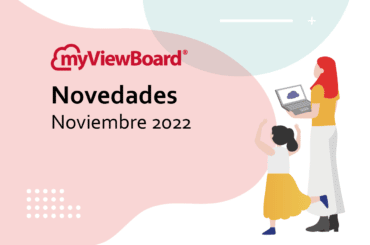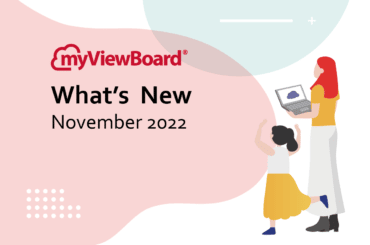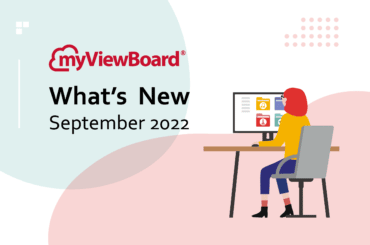This post is also available in: Español (Spanish) 繁體中文 (Chinese (Traditional)) Français (French)
Virtual classrooms are not a new trend, nowadays many students around the world use distance learning as an option. Although, on some occasions experiencing a virtual class is not a voluntary choice (for example, schools responding to emergencies or temporarily shutting down) virtual learning can help fill the gap through complete and interactive online learning environments.
Keep reading to learn about the elements of a virtual classroom solution, how it works, and quick solutions to create one with myViewBoard.
The latest data from Statista on e-learning and education shows that 92% of students worldwide are interested in personalized support and the use of digital devices during the learning process. This means that virtual classrooms are ideal learning environments for a huge number of learners.
Even though educational systems are trying their best to quickly respond to the growing demand for digital teaching technologies, transitioning from a face-to-face environment to a virtual environment can be intimidating for teachers and students. Creating an engaging and meaningful virtual teaching experience takes the right tools, patience, and energy.
But first things first…
What are Virtual Classrooms?

Virtual classrooms are online environments that allow teachers and students to interact during a virtual class using audio, video, text, screen sharing, instant polling, among other features. Great examples of virtual classrooms include Google Classroom and myViewBoard Classroom is These features help simulate real interactions as if teachers and students were face-to-face in a physical classroom.
Why Should You Use Virtual Classrooms?
1. Flexibility
The online environment of a virtual class allows teachers and students to update and adapt their schedules anytime and anywhere. It certainly gives flexibility to busy teachers teaching multiple lessons at various institutions and to students to arrange their schedules at their best convenience. All you need is your laptop or a digital device that can display the virtual content.
Everything should be online. Announcements, assignments, lesson content, student discussions, feedback or simply reaching out to the teacher for questions.
2. Sharpened Digital Skills
There is always a lot to learn out there, it is a matter of exploring. If we don’t know how to upload a listening track, there are some technological tools that can help us to do it, but it is a matter of exploring how and doing it.
Virtual classroom solutions in distance learning have come to stay. With the increasing use of data analytics, virtual reality, and artificial intelligence, digital skills are getting more and more attention. With the use of virtual classrooms, the educational system prepares teachers and students to be ready to respond to these demands. As the whole system continues to adapt to an online world, skillful teachers and students will be substantial to education.
3. Remote Accessible Content
Virtual classrooms allow easy lesson documentation and cloud storage. Documenting your lesson plans is the best way to give your students the opportunity to access to the content anytime and enable learning after the class. There is great value for absent students or for students experiencing temporary troubleshooting during the virtual class. Everyone can easily download and save the lesson content. With the use of virtual classrooms saving your lesson content on the cloud can facilitate content availability and also free up space on your local disk!
You may also want to learn more about Are Free Educational Videos Worth It?
Essential Elements of a Virtual Classroom

1. Interactivity
The first and vital core element of a virtual classroom: interactivity. Active participation creates synergy while teaching the lesson content. Feedback from the students across the screen and shorter periods of self-reflection bring the best results in a virtual class. For ways on how you can include interactivity during a virtual class.
2. Synchrony
Synchrony in a virtual classroom means teachers will engage simultaneously as much as students do during the class. This, for example, will need all participants to ‘join’ to the virtual class to make it happen. Simulating communication through the virtual platform with one another as if they were exchanging words in a face-to-face classroom.
3. Sense of Community
To develop a sense of community in a virtual classroom in real-time collaboration is key. Through online tools, students and teachers can create and edit content together. Creating interaction as a community is important because it helps peer knowledge sharing and promotes a sense of belonging within the students while they’re physically apart.
Take Away
More than a challenge, the adoption of virtual classrooms facilitates the learning process anywhere and for anyone. Virtual classrooms are helping education overcome the challenges presented by the absence of physical classrooms. Now, will the benefits of virtual classrooms become a better option for blended learning? Will schools around the world keep developing their curriculums for the upcoming challenges?
Get more information about distance learning or get started with myViewBoard Suite now.
This article was contributed by Adriana Najera, myViewBoard Global Educator

Adriana Najera
myViewBoard Global Educator
Adriana Najera is one of myViewBoard’s Global Educators at ViewSonic. She is in charge of helping the Latin American and Spanish regions to stay tuned on the latest trends in EdTech.
Adriana currently lives in Taipei, Taiwan and has expertise in customer success and digital content creation. She is fluent in English, Spanish, and basic Mandarin Chinese.





4 Comments
I read and watched the video.
Online classes are very useful at this time
Maybe it’s hard to adjust now but if you learn it well it helps you a lot
Your information is very inspiring. Keep it going. Thanks